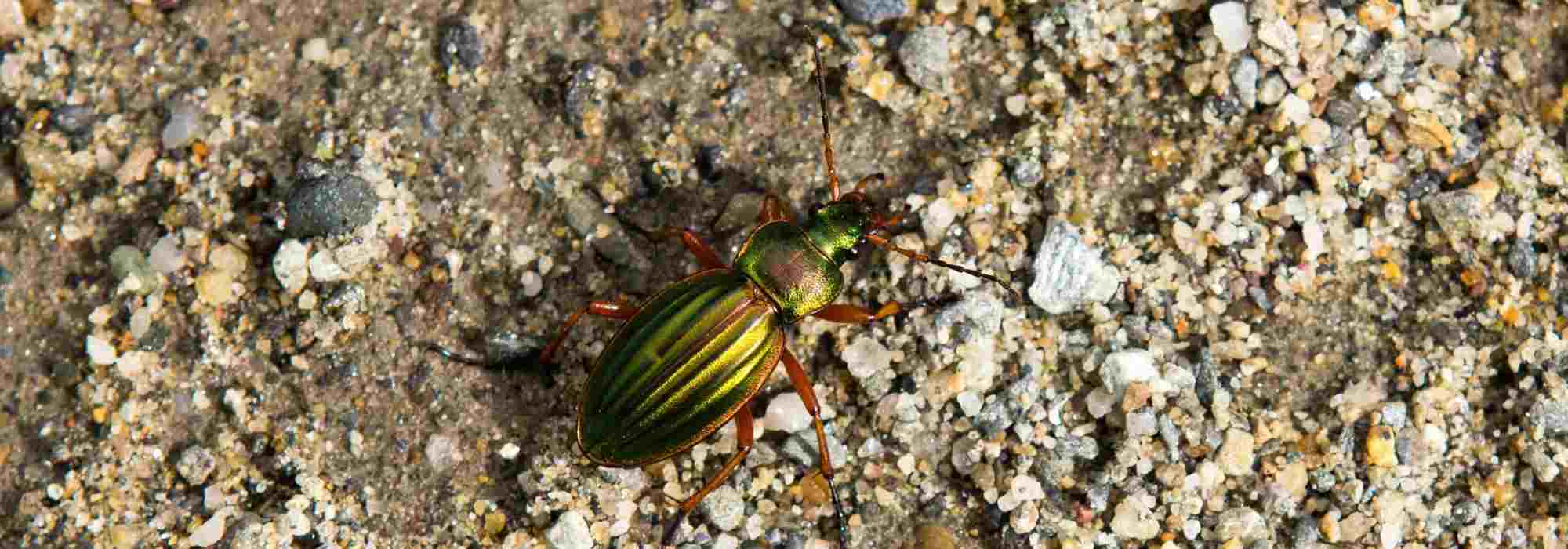
The ground beetle: this unknown friend of the gardener
a very useful insect
Contents
The carabid beetle is a friendly beetle for gardeners, but much less so for its prey. Indeed, it is a very useful auxiliary insect for regulating populations of slugs, snails, caterpillars, and a whole range of other pests or nuisances in the garden. A true friend of the gardener in the ecological fight in both the vegetable garden and the ornamental garden, carabids, including the Golden Carabid, require very little to settle in your garden. All it needs is a garden that is as natural as possible. So, are you ready to make a little space for it in your garden?
Carabid: who are you?
Ground beetles, as there are many species, are insects belonging to the order of Coleoptera and the family Carabidae. This family comprises nearly 40,000 species divided into over 1,800 genera. In France and Belgium, we can encounter only about forty species. However, the most common in our gardens is the Golden Ground Beetle (Carabus auratus).
Adults are recognisable by:
- their large size (15-40 mm)
- their rather elongated body supported by long, fine and agile legs
- their long, beaded antennae
- their long, sharp mandibles
- their hard, striate elytra
Ground beetles are generally dark in colour, but some species, including the golden ground beetle, are distinguished by a beautiful metallic sheen. Most species of ground beetles are apterous (wingless) or have rudimentary wings: ground beetles do not fly but run on the ground.
The larvae of ground beetles are black and have three pairs of legs, a grinding mouthpart, a dorsoventrally flattened body, and a large head. They are agile and predatory.
In France, the total population of ground beetles is reported to have declined by 85% since 1990.
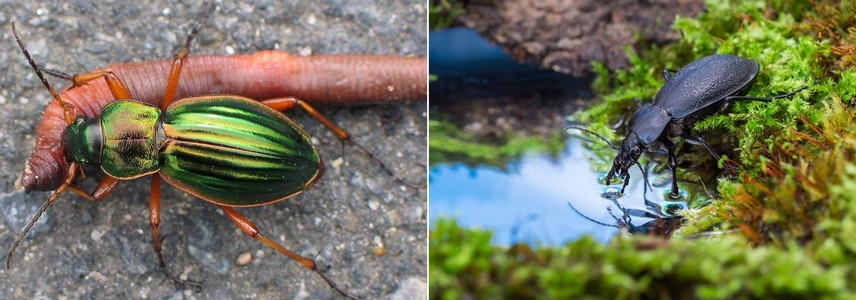
Golden ground beetle carrying an earthworm (Soebe – Wikipedia) – Ground beetle drinking
The biology of ground beetles
Eggs are laid in moist soil either in spring or autumn depending on the species. The larvae that emerge are primarily carnivorous. Carabid larvae bite their small prey and inject enzymes. These enzymes begin to pre-digest the prey (similar to spiders) so that the larva can consume it more easily. The carabid larva goes through various larval stages before reaching the adult stage: metamorphosis is complete (holometabolous). The larva transforms into a pupa (pupation) and then emerges from the ground or a natural cavity (in some species). Most of the time, only one year passes between the egg and the adult stage (imago), but for some species in harsher climates, this duration can extend up to four years.
Adults are often omnivorous and more rarely phytophagous. They mostly emerge only at dusk to hunt and spend their days sheltered in a cool, moist place. Carabids hunt their prey on the ground or in vegetation and can reach speeds of up to 8 km/h. This places them among the fastest animals on earth relative to their size.
Carabids can live up to 3 years. Carabid populations take between 2 and 5 years to develop properly. They hibernate in piles of wood or leaves, or within an old stump.
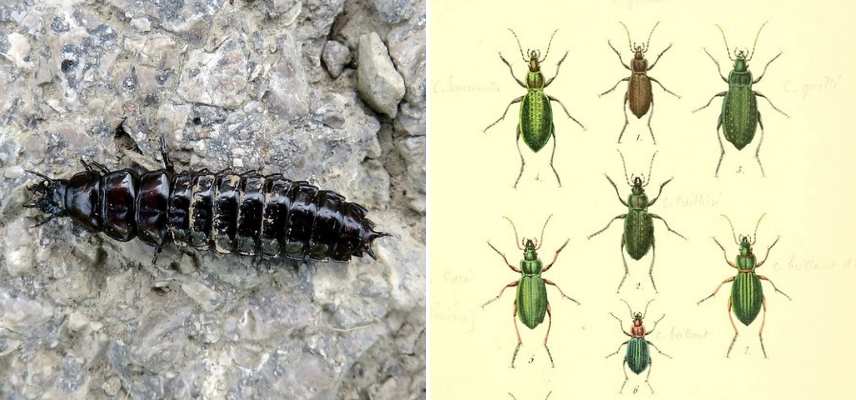
On the left, the larva of a carabid (© Vahe Martirosyan); on the right, a botanical plate from 1876 depicting some of the many species of carabids
The ground beetle is the gardener's friend.
The carabid beetle is an essential link in the food chain, being both a predator and prey. It is a prime target for owls, toads, and hedgehogs.
Where the carabid, both adult and larva, proves to be an excellent ally for gardeners is in its role as an effective predator against slugs and snails. However, it also consumes the larvae of codling moths (apple worms), caterpillars, aphids, wireworm larvae, chrysomelids, and Colorado beetles, as well as nematodes… but, less favourably, earthworms and spiders. Nevertheless, it is one of the most effective auxiliary insects in biological control against various pests or nuisances in our gardens.
Some carabids also consume seeds of adventive plants, according to a 2011 study by INRA. This helps regulate the presence of “weeds” in gardens or crops.
According to some authors, the presence of carabids is also a good indicator of biodiversity in a medium, both in nature and in gardens.
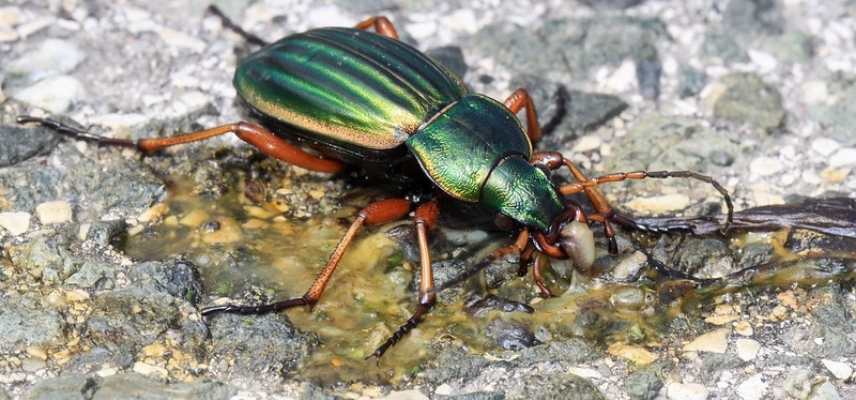
Golden carabid devouring a slug (© gbohne)
How to attract ground beetles to your garden?
- Minimise tillage or soil work to avoid destroying the eggs of ground beetles found in the soil;
- Maintain permanent ground cover in both ornamental gardens and vegetable plots. In other words, let’s avoid bare soil! Several solutions are possible: groundcover, green manure, dense planting… and of course, mulching.
- Allow native wild plants to grow: at the base of trees and hedges, keeping some areas uncut… It is worth noting that the presence of phacelia seems to encourage ground beetles. Also, avoid overly large mown areas, as it makes it difficult for ground beetles to move without being caught by one of their predators;
- Keep old stumps, piles of wood, piles of dead leaves, or piles of stones: this provides shelter for ground beetles during the day or even for hibernation;
- Forget slug traps, such as beer traps, where slugs fall into the liquid on the soil surface. Ground beetles, attracted more by distressed slugs than by beer, also fall in and drown. (Save the beer for your own enjoyment!).
And of course, completely ban all pesticides, weedkillers, insecticidal products, and other chemical or so-called natural “cides“!
- Subscribe!
- Contents
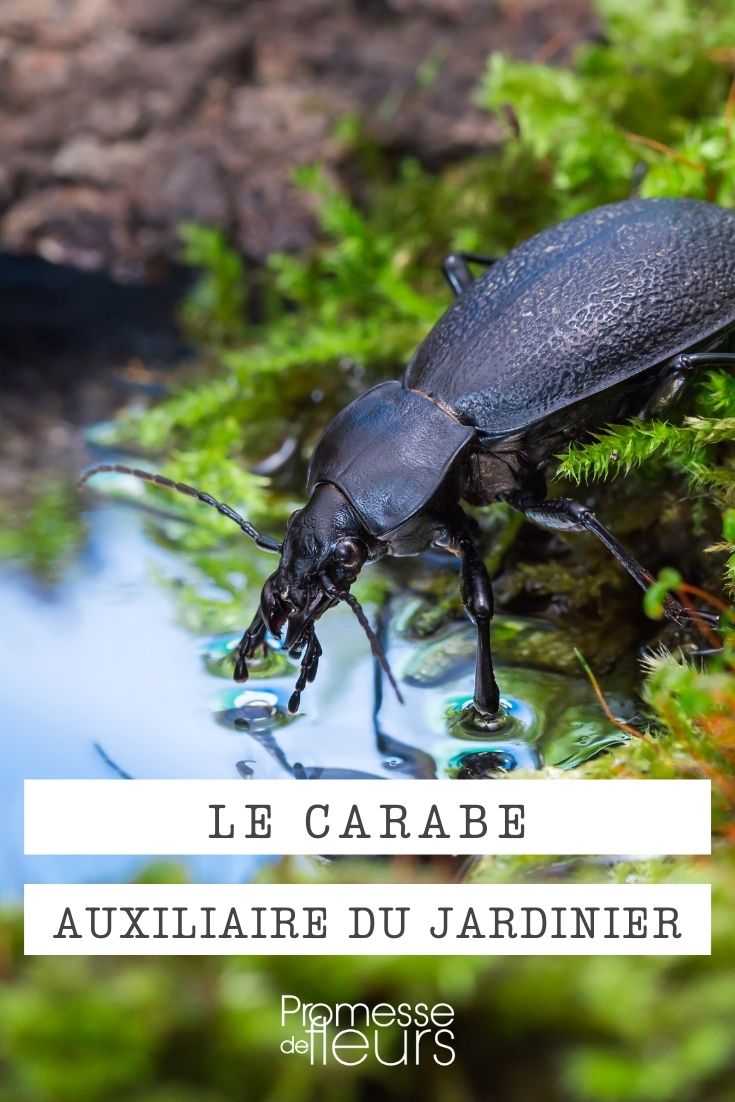






























Comments